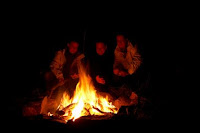I first heard this story when
I was seven. My older sister who was in high school in the early 1960s often
told my other sister and myself stories she heard at school, or while she was
out with friends, on dates etc.
The story of The Hook was first told in the 1950s.
During this time Lovers Lanes where teens drove to make-out were at there most
popular.
This story was originally
told as a cautionary tale to scare teens away from promiscuous activities.
The high school football star
and his girlfriend were out on a Friday night date. After
the obligatory meal and movie he drove out to the overlook where the town’s
Lover’s Lane was located.
He parked his car so they had
a nice view of the city lights. It was a cold fall night so they rolled their
windows up and he tuned his radio low to a pop station.
As they began to kiss they
were startled to hear a loud bulletin blare from the radio. It was a warning, a
convict had escaped from a nearby prison and everyone was to be on the lookout.
The man was believed to still
be wearing his prison clothes and he could be identified from the fact that he
had a hook instead of a left hand.
This damped the romantic mood
and the girl wanted to head home but her boyfriend reassured her there was
nothing to worry about, the prison was on the opposite end of their town.
The two teens soon forgot the
warning and continued to make out until the girl heard something that sounded
like a scratching on the car door nearest her.
She jerked up and asked her
boyfriend if he had heard it too. Annoyed at the interruption he told her no.
He told her there was nothing to be scared of. He proceeded to kiss her once
more but she heard the scratches again.
She firmly pushed him away
and stated that it was not her imagination something was outside moving around
their car in the dark.
Realizing he could not
recapture the mood the boy shook his head in disgust. She pressed closer to his
side and gripped his arm as she heard the scratching once more.
She insisted he take her home.
Angry and frustrated he
turned the engine on and backed the car out more quickly than he intended. The
pair barely talked as he drove her home.
By the time he stopped at the
front of her house, he had cooled down. Being a gentleman he got out of his car
to open her door. When he reached out to pull the handle open he stopped.
There hanging from the
passenger side door handle was a bloody hook.





























